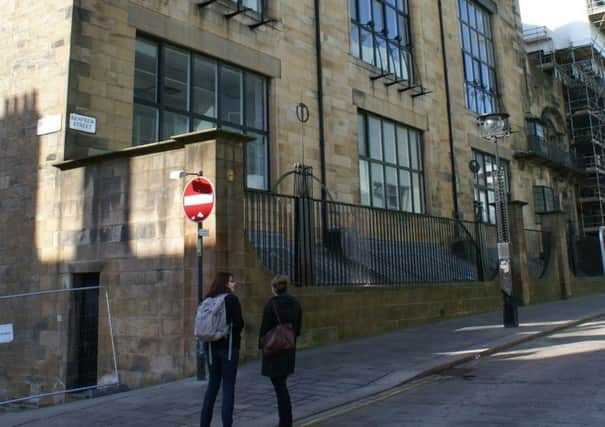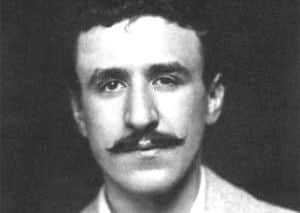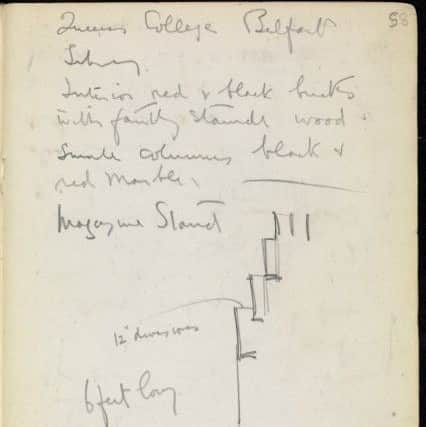Architect of Glasgow's recently burnt out School of Art had plans for Belfast


Belfast’s tall yellow cranes, the double-legacy of Harland and Wolff’s shipbuilding prowess, aren’t quite as spectacular as India’s Taj Mahal or as vast as the Great Wall of China, but Samson and Goliath are loved and cherished as symbols of the River Lagan’s former-day supremacy as a vital industrial artery to the rest of the world.
London has Big Ben, Italy has the Tower of Pisa, San Francisco has the Golden Gate…and Glasgow has ‘the Mack’.
Advertisement
Hide AdAdvertisement
Hide AdSadly, the endearingly nicknamed Glasgow School of Art designed by Charles Rennie Mackintosh, was severely damaged by fire in the early hours of Saturday morning.


There’s a poignant postscript to the weekend inferno.
Mackintosh’s iconic, much-loved building was still under restoration after a fire four years ago and some his fixtures and fittings which survived the first blaze were still in storage, thus undamaged by the second fire.
Charles’s attention to detail was extraordinary, revealed in his meticulously drawn plans for the building’s smaller and larger furnishings and decorations.
And while one of his drawings confirms Mackintosh’s eye for detail, it proves that he also had his eye on Belfast.


Advertisement
Hide AdAdvertisement
Hide AdSometime around 1910, on a page in his sketchbook entitled Queen’s College Belfast Library, Mackintosh noted the “red and black bricks” and the “black and red mortar” while he sketched an interior detail of the library.
The designer of Glasgow’s iconic School of Art undoubtedly had an interest in expanding his portfolio from Scotland to Ireland.
And there’s more than a little evidence that he also had his eye on the competition to design Belfast City Hall in 1896.
A News Letter report at the time recounted controversy surrounding the project, with proposals “for so large and complex a building” that would take months to complete.
Advertisement
Hide AdAdvertisement
Hide AdAnd when Mackintosh was working as an architect in Glasgow’s Honeyman, Keppie and Mackintosh partnership, some notes in his sketchbook suggest that Charles Rennie intended entering the 1910 competition for additions to the library at Queen’s College Belfast, renamed Queen’s University.
He certainly visited the library, making some detailed drawings and writing down his observations.
If he did enter the competition, he didn’t win it, and Belfast was never able to boast its own Mack.
Charles entered a lot of competitions around that time, apparently with little success.
Advertisement
Hide AdAdvertisement
Hide AdA letter to a friend in November 1902 shows how much of his time was absorbed fruitlessly by these speculative designs – “I am very busy just now at two large buildings in connection with competitions – that makes eight competitions I have entered since the end of May and I have not got one of them so far. I have still another to do before we come to stay with you in London.”
Just who was Charles Rennie Mackintosh?
He was born in Glasgow in 1868 and life wasn’t easy for the young lad.
From childhood he suffered from disabilities.
He walked with a limp and developed a problem with his right eye which caused it to droop.
Because of this Charles was encouraged to spend time in the countryside when he was young.
Advertisement
Hide AdAdvertisement
Hide AdIt was his love of the countryside and flora which was to manifest itself later in his life.
Mackintosh enrolled in the first Glasgow School of Art when he was only 15 years old.
A year later he joined the John Hutchison architectural practice to train as a draughtsman.
After completing his apprenticeship he moved to the Honeyman and Keppie partnership in 1889 and a year later won the coveted Alexander Thomson Travelling Studentship for Public Design.
Advertisement
Hide AdAdvertisement
Hide AdWith his prize of £60 he decided to travel to Italy and Europe, a trip that was to change his work after he developed an individual style, influenced greatly by his experiences on the continent.
Japanese Art also added a depth to his new-found ideas.
Mackintosh continued studying at night-time at the Glasgow School of Art where a new principal, Francis Newberry, radically transformed the syllabus.
Newberry encouraged the students to follow the latest trends in art, design, crafts and architecture.
It was here that Charles Rennie met fellow-artist Margaret MacDonald, whom he married and worked with.
Advertisement
Hide AdAdvertisement
Hide AdHis designs for the new Art School were built between 1897 and 1909, when Charles became a partner in the Honeyman and Keppie architectural practice in 1907.
The couple later moved to England from 1914 to 1922, where Charles produced many beautiful watercolour paintings.
The couple holidayed in the south of France in 1923 and moved there permanently in 1925, when Charles painted many beautiful landscapes.
The couple remained in France until 1927, when illness forced them to return to London.
Advertisement
Hide AdAdvertisement
Hide AdSadly, Charles was diagnosed with throat and tongue cancer and died on December 10th 1928 at the age of 60.
Margaret passed away on January 10th 1933, five years after her beloved husband.
While Scotland grieves the terrible damage done by fire to Glasgow’s School of Art, we in Northern Ireland might take a moment to consider how close we may have been to having one, or maybe two, Mackintosh buildings in Belfast.